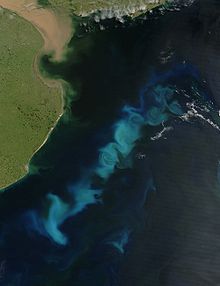Phytoplankton: Difference between revisions
No edit summary |
|||
| Line 22: | Line 22: | ||
==Reference== |
==Reference== |
||
*[http://saga.pmel.noaa.gov/review/dms_climate.html DMS and Climate] |
*[http://saga.pmel.noaa.gov/review/dms_climate.html DMS and Climate] |
||
*[http://www.newplankton.com/marine-phytoplankton.htm Phytoplankton Diversity of Plant-based Green Food Nutrients] |
|||
[[Category:Biological oceanography]] |
[[Category:Biological oceanography]] |
||
Revision as of 19:59, 15 May 2006

Phytoplankton refers to the autotrophic component of the plankton that drifts in the water column. The name comes from the Greek terms, phyton or "plant" and , meaning "wanderer" or "drifter". Most phytoplankton are too small to be individually seen with the unaided eye. However, when present in high numbers, their presence may appear as discoloration of the water (the color of which may vary with the phytoplankton present).
Phytoplankton, like plants, obtain energy through a process called photosynthesis, and so must live in the well-lit surface layer (termed the euphotic zone) of an ocean, sea, or lake. Through photosynthesis, phytoplankton (and terrestrial plants) are responsible for much of the oxygen present in the Earth's atmosphere. Their cumulative energy fixation in carbon compounds (primary production) is the basis for the vast majority of oceanic and some freshwater food chains (chemosynthesis is a notable exception). As a side note, one of the more remarkable food-chains in the ocean—remarkable because of the small number of links—is that of phytoplankton fed on by krill (a type of shrimp) fed on by baleen whales.
While almost all phytoplankton species are obligate photoautotrophs, there are some that are mixotrophic and other, non-pigmented species that are actually heterotrophic (the latter are often viewed as zooplankton). Of these, the best known are dinoflagellate genera such as Noctiluca and Dinophysis, that obtain organic carbon by ingesting other organisms or detrital material.
In terms of numbers, the most important groups of phytoplankton include the diatoms, cyanobacteria and dinoflagellates, although many other groups of algae are represented. One group, the coccolithophorids, is responsible (in part) for the release of significant amounts of dimethyl sulfide (DMS) into the atmosphere. DMS is converted to sulfate and these sulfate molecules act as cloud condensation nuclei, increasing general cloud cover.
Phytoplankton, like other plants, obtain energy through a process called photosynthesis and so must live in the well-lit surface layer of an ocean, sea or lake. Through photosynthesis phytoplankton produce approximately 98% of atmospheric oxygen.
See also


